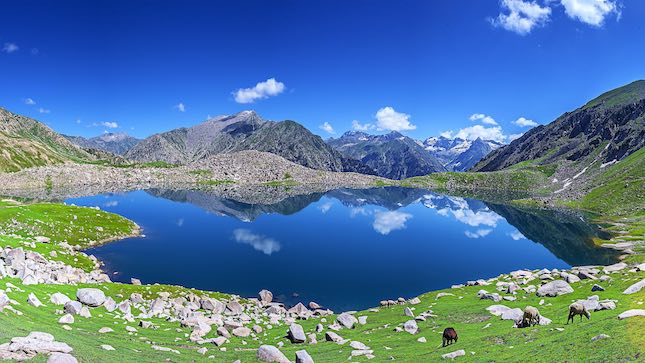- Advertisement -
PESHAWAR, Apr 18 (APP):Beneath the lush valleys and snow-capped peaks of Swat lies a legacy that spans millennia—one of empires, enlightenment, and the enduring spirit of Gandhara civilization.
For most, Swat is a paradise of rivers, snowfall, trout, orchards, lakes and adventure. But for those who delve deeper, it is a cradle of history whispering tales of ancient Buddhists, Greek invaders, medieval rulers, and resilient locals that inspired many visitors.
Often called the “Switzerland of the East,” Swat Valley, nestled in the north of Khyber Pakhtunkhwa, has been home to one of the most diverse culture, hospitality and ancient civilizations of the South Asia.
“The Sangaro Cave excavations in village Mian Khan, Mardan, led by renowned archaeologists Ahmad Hasan Dani and Farid Khan in 1963, revealed remains from the Middle Paleolithic period—dating back 9,000 to 27,000 years in KP including Swat,” said Bakhtzada Muhammad, Deputy Director, Archaeology and Museums, while speaking to APP.
He noted that excavations at Khanpur in Haripur and Sangaro Cave unearthed primitive tools and artifacts from the Mesolithic era (10,000 to 8,600 years ago), underscoring the presence of early human life in Swat and Dir districts of Malakand division.
“Evidence from ancient sites like Mehergarh in Balochistan, Rehman Dheri in D.I. Khan, and Sheri Khan Tarakai in Swabi shows that people were making stone and clay utensils and living in mud houses during the Neolithic era, around 8,000 years ago and Swat remained the centre point of archeologists,” he said.
The graves attributed to Aryan settlers from around 2000 BC were found in Aligrama (Swat), Sangota (Chitral), and Timergara (Lower Dir). Entering from present-day Afghanistan, these semi-nomadic Aryans settled along the Swat, Gomal, Kurram, and Kabul rivers before migrating further into India.
“Literacy and inscription practices in Swat, Dir, Mardan, Charsadda, Peshawar, and Malakand—regions central to the Gandhara civilization—began under Persian rule, with stone-carved scripts as early evidence,” he said.
“Swat became part of the Gandhara Kingdom after the Persians conquered it in the 6th century BC and integrated it into the Achaemenid Empire,” Bakhtzada explained. “It grew under influences of Greek, Persian, and Central Asian.”
With the spread of Buddhism, he said Swat flourished as a spiritual and artistic hub and ancient sites like Butkara Stupa, Udegram, and the Jehanabad Buddha are enduring symbols of this era, merging Hellenistic artistry with Buddhist symbolism and attracting scholars and pilgrims alike.
In 327 BC, he said Alexander the Great invaded through the Khyber Pass, meeting fierce resistance from the Yousafzai tribes around Swat and Kunar. The Indo-Greeks—around 39 rulers in total—later established a unique Greco-Buddhist culture in the region, traces of which still survive in local art and architecture.
In 1505, Zaheeruddin Babar, founder of the Mughal Empire, entered KP via Khyber Pass, capturing Kohat and Bannu before defeating the Lodhi dynasty and becoming Emperor of Delhi.
“Islam gradually replaced Buddhism starting in the 11th century and Swat emerged as a center of Islamic scholarship and eventually became a princely state under Miangul Abdul Wadud in the early 20th century.”
Despite external influences, he said that Swat retained considerable autonomy, with its own judicial and administrative systems until it merged with Pakistan in 1969.
Today, the region’s historical legacy is preserved in places like the Swat Museum—a treasure trove built in 1959 by Wali of Swat Miangul Jehanzeb in collaboration with the Italian archaeological mission.
“The Buddhist sculptures and rare artifacts in the Swat Museum are fascinating,” said Umar Khan, a tourist, adding, “Swat could draw global attention if its archeological heritage is promoted digitally.”
The museum houses over 3,000 artifacts, with detailed displays of Gandharan sculptures that narrate the Buddha and Swat’s people’s life. Its ethnographic section showcases Swat’s traditional embroidery, woodwork, and antique jewelry.
Exploring Swat is like leafing through a history book etched in stone and soul. It’s a valley that tells a timeless story—of bravery, resilience, cultural fusion, and the enduring human spirit.
The experts said it was a time to promote Swat’s Ghandara heritage, its Malam Jabba and Kalam’s snowfall, Madain valley’s trout fish and awesome Mahudhand lake through social media platforms through small videos imperative to attract foreign tourists to explore and attract valuable foreign exchange for the country.

